Vous vous demandez ce qui stimule la croissance d'un enfant durant ses premières années ? Pourquoi certains enfants excellent-ils en langage tandis que d'autres s'épanouissent dans le mouvement ou l'interaction sociale ? Vous ne savez pas comment concilier développement physique, émotionnel et intellectuel dans votre programme de maternelle ? Ces questions perturbent souvent les parents et les éducateurs qui tentent de soutenir le développement global de l'enfant.
Comprendre les domaines de développement est essentiel pour répondre à ces préoccupations. Ces domaines sont fondamentaux et déterminent la croissance et le fonctionnement des enfants. Ils comprennent le développement physique, cognitif, langagier, socio-émotionnel et adaptatif. En reconnaissant et en favorisant chaque domaine, nous permettons aux enfants d'atteindre leur plein potentiel. Les éducateurs, les soignants et les parents jouent tous un rôle essentiel pour soutenir ces domaines, que ce soit par l'apprentissage par le jeu, des routines structurées ou des interactions réactives.
Vous souhaitez comprendre les véritables moteurs du développement de la petite enfance ? Suivez-nous pour analyser chaque domaine de développement, expliquer leur interaction et découvrir des stratégies simples et concrètes pour accompagner les enfants à chaque étape de leur développement. Plongeons dans le monde fascinant du développement de la petite enfance !
Que sont les domaines de développement ?
Les domaines de développement désignent les aspects clés de la croissance et de l'apprentissage d'un enfant, chacun représentant un aspect fondamental du développement humain. Ces domaines aident les éducateurs, les soignants et les professionnels à comprendre comment les enfants acquièrent des compétences, s'adaptent à leur environnement et se préparent à l'apprentissage tout au long de leur vie. L'observation des progrès dans plusieurs domaines nous donne une vision globale des capacités et des besoins de développement d'un enfant.
Chaque domaine interagit avec les autres de manière dynamique. Par exemple, le développement du langage peut influencer les compétences socio-émotionnelles, et la croissance physique peut affecter le fonctionnement cognitif. Reconnaître ces interdépendances permet de mettre en place des pratiques plus efficaces pour la petite enfance et un soutien ciblé.
Les cinq domaines de développement généralement reconnus dans l’éducation de la petite enfance :
- Domaines de développement physique
- Domaines de développement cognitif
- Domaines de développement du langage et de la communication
- Domaines de développement socio-émotionnel
- Domaines de développement adaptatif (auto-assistance)
Domaines de développement physique
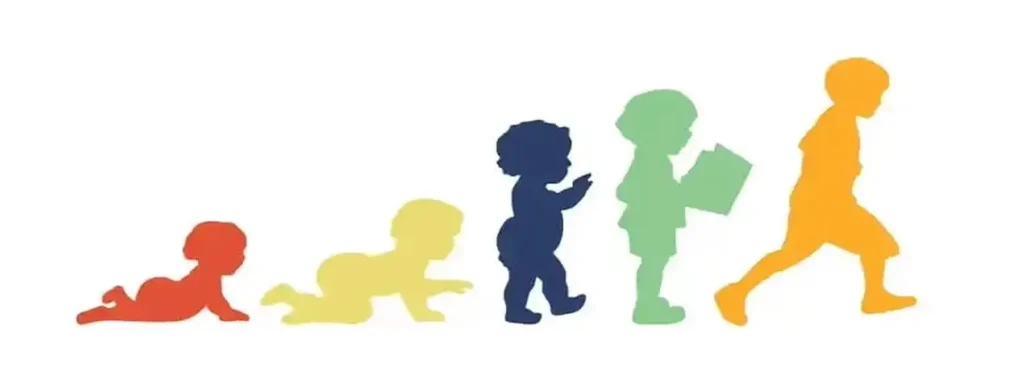
Le développement physique constitue le fondement des premiers apprentissages et du fonctionnement quotidien d'un enfant. Il englobe les changements de taille, de motricité, de force, de coordination et de santé globale. Ce domaine est souvent le plus observable chez les jeunes enfants. À mesure qu'ils grandissent, leurs capacités physiques se développent rapidement, leur permettant de se déplacer avec plus de contrôle et d'interagir avec plus d'assurance avec le monde qui les entoure.
Aspects clés du domaine physique
- Motricité globale
La motricité globale fait appel à de grands groupes musculaires qui contrôlent les mouvements du corps, comme s'asseoir, se lever, marcher, courir, sauter et grimper. Ces compétences favorisent l'équilibre, la coordination et la perception spatiale. - Motricité fine
Le développement de la motricité fine fait référence aux petits mouvements musculaires des mains et des doigts, essentiels pour des activités comme dessiner, écrire, boutonner ou manipuler de petits jouets. Une bonne motricité fine est essentielle pour les tâches scolaires et l'autonomie. - Développement sensoriel
Le développement sensoriel comprend l'intégration et la réponse aux stimuli des cinq sens : la vue, l'ouïe, le toucher, le goût et l'odorat. Il favorise la coordination, la planification motrice et la régulation émotionnelle. - Croissance et changements physiques
Cela comprend des changements mesurables de taille, de poids, de masse musculaire et du développement des os et des systèmes corporels. Le suivi de la croissance physique est essentiel pour détecter tout problème nutritionnel ou de développement.
Domaines de développement physique à différents âges
Le développement physique est un processus continu et progressif qui varie considérablement selon les différentes étapes de la petite enfance. Chaque groupe d'âge – nourrissons, tout-petits et enfants d'âge préscolaire – franchit des étapes uniques qui reflètent le développement de sa force, de sa coordination, de son équilibre et de sa motricité. Comprendre ce qui est approprié au développement de chaque étape permet aux soignants et aux éducateurs de créer des environnements et des expériences propices à l'évolution de ces compétences.
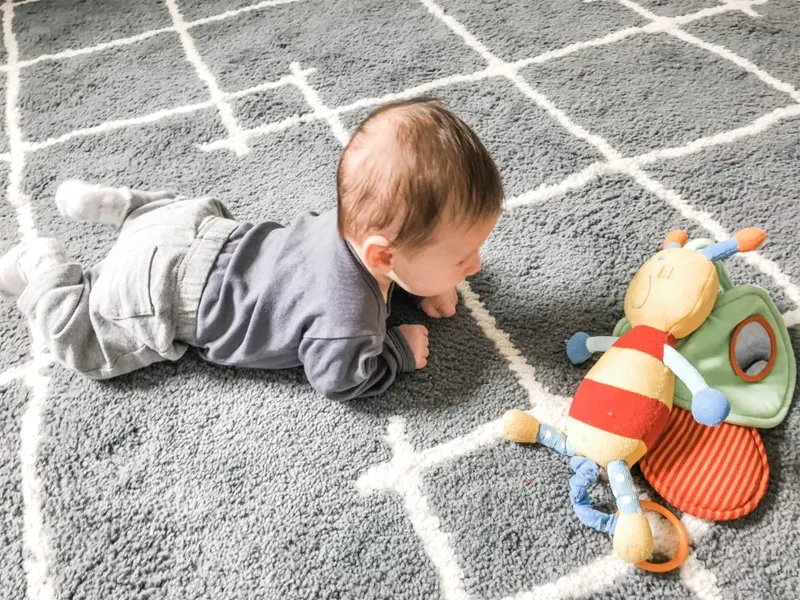
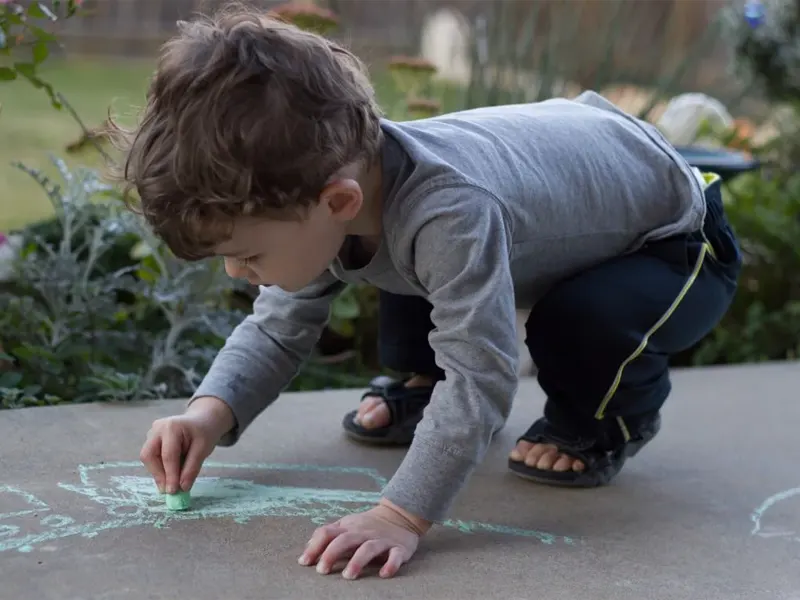
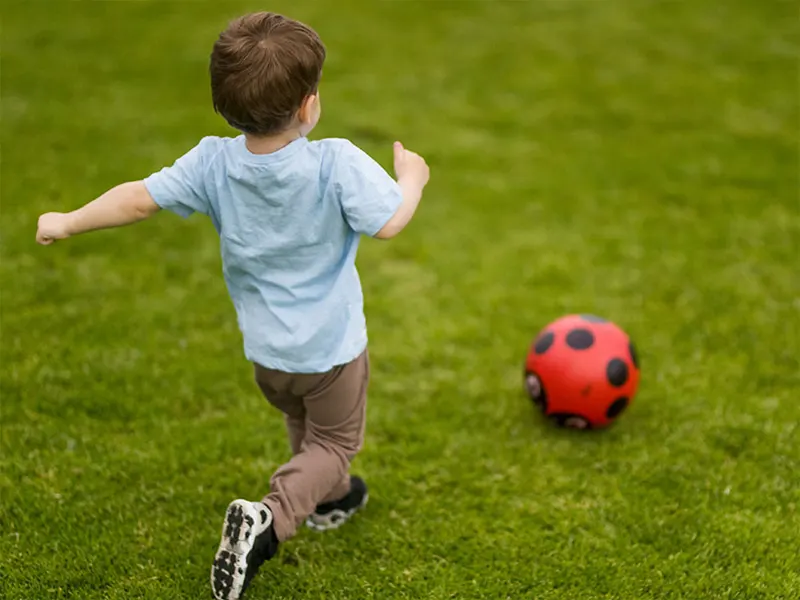
Nourrissons (de la naissance à 12 mois)
Étapes clés du développement :
- 0–3 mois : Lève brièvement la tête lorsqu'il est sur le ventre, bouge les bras et les jambes symétriquement, commence le réflexe de préhension
- 4 à 6 mois : Se retourne, se redresse sur les bras, attrape les jouets, commence à s'asseoir avec un soutien
- 7–9 mois : S'assoit de manière autonome, transfère des objets entre ses mains, commence à ramper ou à se déplacer
- 10–12 mois : Tire pour se lever, se déplace le long des meubles, peut faire ses premiers pas, utilise une prise en pince pour ramasser de petits objets
Stratégies pour soutenir le développement physique :
- Accordez-lui du temps quotidien sur le ventre pour renforcer le haut du corps et le cou.
- Offre jouets de différentes textures et tailles pour encourager l'atteinte, la préhension et l'exploration sensorielle
- Créez un espace au sol sûr pour la libre circulation et la rampement
- Utiliser des miroirs et des visuels à contraste élevé pour motiver les mouvements des yeux et de la tête
- Encouragez-le à tirer pour se lever et à naviguer avec mobilier d'écurie ou pousser des jouets
Tout-petits (1 à 3 ans)
Étapes clés du développement :
- Marche de façon autonome et commence à courir, grimper et taper dans un ballon
- S'accroupit pour ramasser les jouets, pousse et tire les jouets en marchant
- Commence à utiliser les escaliers avec de l'aide, empile des blocs et griffonne avec des crayons
- Commence à utiliser des ustensiles et des tasses ouvertes pour se nourrir, tourne les pages des livres cartonnés
Stratégies pour soutenir le développement physique :
- Encouragez l'escalade, la rampement et l'équilibre en toute sécurité à l'aide d'équipements intérieurs et extérieurs
- Incluez des jeux de mouvement quotidiens comme la danse, la chasse aux bulles ou les parcours d'obstacles
- Offre matériel d'art et des jouets de manipulation (par exemple, de la pâte à modeler, des blocs) pour affiner la motricité fine
- Promouvoir les tâches d’auto-assistance (par exemple, se nourrir, se laver les mains) pour favoriser la coordination et l’indépendance
- Fournir des jouets à pousser et à tirer, des tricycles et des balles texturées pour la stimulation motrice globale
Enfants d'âge préscolaire (3 à 5 ans)
Étapes clés du développement :
- Saute, sautille et s'équilibre sur un pied pendant quelques secondes
- Monter et descendre les escaliers en alternant les pieds
- Lance et attrape une balle, pédale sur un tricycle et grimpe sur les structures de jeux en toute confiance
- Utilise des ciseaux, dessine des formes et des figures humaines de base, boutonne et déboutonne les vêtements
Stratégies pour soutenir le développement physique :
- Organisez des jeux de groupe structurés comme la marelle, les courses de relais ou le yoga pour améliorer l'équilibre et la coordination
- Fournir des postes de motricité fine avec des puzzles, des perles, des pinces et des jeux de construction
- Encouragez l'exploration quotidienne en plein air avec la course, le saut et le jeu imaginatif
- Utilisez des horaires et des graphiques visuels pour favoriser les routines d'habillage et d'hygiène indépendantes
- Intégrer le mouvement dans l’apprentissage scolaire (par exemple, compter en sautant, tracer des lettres avec les doigts)
Obtenez notre catalogue complet
Envoyez-nous un message si vous avez des questions ou si vous souhaitez obtenir un devis. Nos experts vous répondront dans les 48 heures et vous aideront à sélectionner le produit qui vous convient.
Pourquoi les domaines de développement physique sont importants
| Zone clé | Pourquoi c'est important |
|---|---|
| Fondamentaux pour l'apprentissage | La préparation physique favorise l’attention, la participation et l’engagement dans l’apprentissage. |
| Prend en charge d'autres domaines | La motricité globale et fine améliore le développement cognitif, social et émotionnel. |
| Favorise l'indépendance | Permet aux enfants d’effectuer des tâches d’autonomie comme s’habiller, se nourrir et aller aux toilettes. |
| Encourage l'exploration | Le mouvement permet aux enfants de découvrir, d’interagir et de donner un sens à leur monde. |
| Renforce la confiance | La maîtrise des compétences physiques favorise le sentiment de compétence et l’estime de soi. |
| Améliore la santé et la forme physique | Le développement physique actif favorise la force, la coordination et la santé à long terme. |
Domaines de développement cognitif
Le développement cognitif désigne la façon dont les enfants pensent, explorent, se souviennent et comprennent le monde. Il implique le développement de processus mentaux tels que la perception, la mémoire, le langage, la résolution de problèmes et la prise de décision. Psychologue suisse Jean Piaget ont identifié quatre stades universels du développement cognitif, que les enfants franchissent selon une séquence fixe. Ces stades nous aident à comprendre l'évolution de la pensée des enfants avec l'âge et l'expérience. En identifiant les caractéristiques de chaque stade, les soignants et les éducateurs peuvent soutenir l'apprentissage par des méthodes adaptées à l'âge et enrichir le développement cognitif des enfants.
Stade sensorimoteur (de la naissance à 2 ans)
Durant le stade sensorimoteur, les nourrissons découvrent leur environnement par leurs sens et leurs actions physiques. À ce stade, le développement cognitif repose sur l'exploration des objets, la réponse aux stimuli et l'établissement précoce de relations de cause à effet. Les enfants commencent à acquérir la permanence des objets, c'est-à-dire la compréhension que les choses continuent d'exister même hors de vue, une étape cognitive importante. Ce stade est divisé en plusieurs sous-phases qui représentent le développement progressif des compétences cognitives.
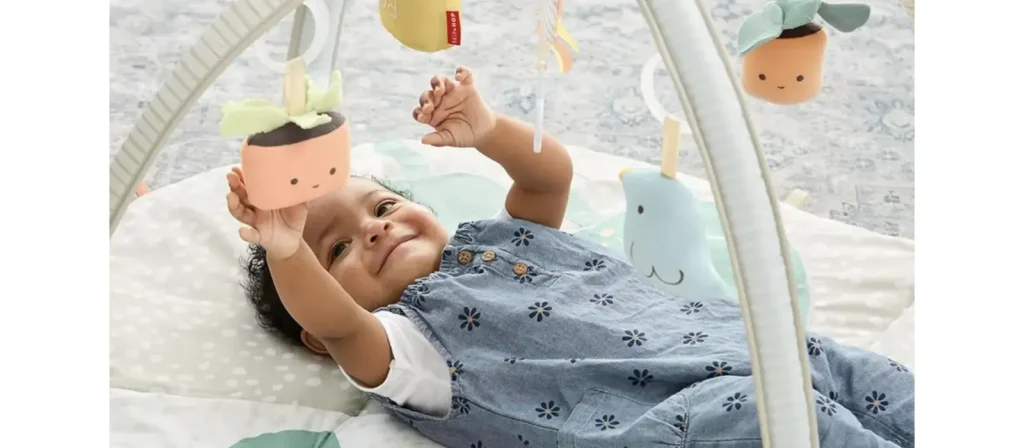
- Réflexes (0-1 mois)
- Réactions circulaires primaires (1 à 4 mois)
- Réactions circulaires secondaires (4 à 8 mois)
- Coordination des réactions circulaires secondaires (8-12 mois)
- Réactions circulaires tertiaires (12-18 mois)
- Pensée représentationnelle précoce (18-24 mois)
Étapes clés du développement :
- Commence à suivre visuellement les objets et les personnes
- Explore en utilisant la bouche, les mains et les mouvements du corps
- Développe la permanence de l'objet vers 8 à 12 mois
- Comprend la relation simple de cause à effet (par exemple, secouer un hochet fait du bruit)
- Imite les gestes et les expressions faciales
- Montre des comportements intentionnels (par exemple, appuyer sur des boutons, ouvrir des portes)
- Commence à utiliser des outils de base (par exemple, une cuillère, un marteau jouet)
Stratégies pour soutenir les progrès des enfants dans le domaine cognitif :
- Offrir une expérience sensorielle sûre matériel de jeu (par exemple, jouets texturés, hochets, instruments de musique)
- Utilisez des jeux de cache-cache et de cache-cache pour renforcer la permanence des objets
- Encouragez les actions répétitives, telles qu'empiler ou remplir/vider des conteneurs
- Lisez des livres d'images simples et décrivez des actions pour développer la mémoire et le langage
- Créez des routines avec des modèles prévisibles pour favoriser la compréhension des causes et des effets
- Offre miroirs et jouets qui répondent aux actions pour favoriser la conscience de soi et la rétroaction
Stade préopératoire (de 2 à 7 ans)
Les enfants en phase préopératoire commencent à utiliser des symboles, notamment le langage, pour représenter des objets et des idées. Ils développent leur imagination, s'adonnent à des jeux de rôle et ont souvent une vision égocentrique du monde, ce qui signifie qu'ils ont du mal à voir les choses du point de vue d'autrui. Bien que leur pensée soit riche et imaginative, elle manque encore de logique et de cohérence.
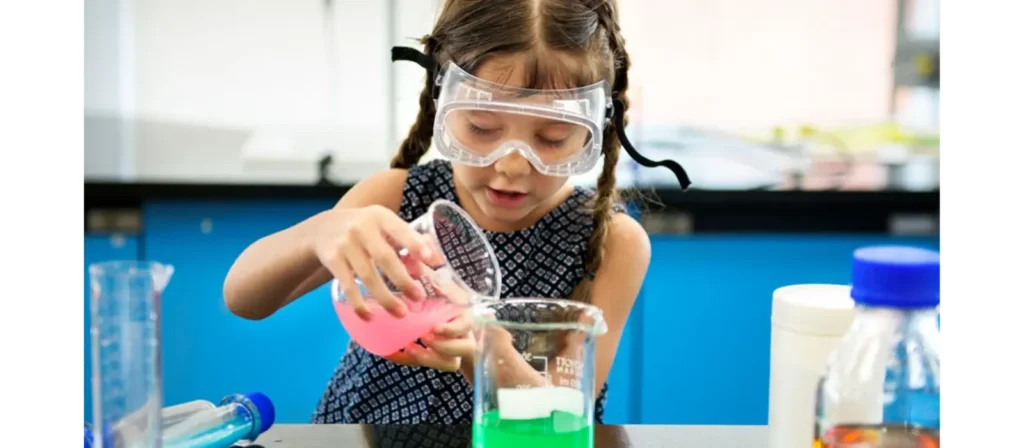
Étapes clés du développement :
- Utilise le langage pour décrire des objets, des actions et des pensées
- S'engage dans un jeu imaginatif et symbolique
- Démontre une pensée égocentrique (par exemple, suppose que tout le monde voit ce qu'il voit)
- Difficultés à comprendre la conservation (par exemple, la même quantité d'eau dans des verres de tailles différentes)
- Commence à classer les objets par couleur, forme ou fonction
- Pose de nombreuses questions « pourquoi » et « comment » pour comprendre le monde
Stratégies pour soutenir les progrès des enfants dans le domaine cognitif :
- S'engager dans jeu dramatique, jeux de rôle et narration pour stimuler la pensée symbolique
- Utilisez des questions ouvertes pour stimuler le raisonnement et la croissance du vocabulaire
- Encouragez le tri et la catégorisation des jeux (par exemple, par taille, couleur ou type)
- Fournir des objets pratiques comme des blocs, des compteurs ou des puzzles pour un apprentissage actif
- Introduire des activités scientifiques simples pour favoriser la curiosité et l'observation
- Utilisez des aides visuelles et des histoires pour expliquer de nouveaux concepts et idées
Étape opérationnelle concrète (7 à 11 ans)
Cette étape marque un bond en avant significatif dans le développement cognitif. Les enfants commencent à réfléchir logiquement à des événements concrets et comprennent les concepts de conservation, de réversibilité et de cause à effet. Ils peuvent organiser l'information, effectuer des opérations mentales et adopter différents points de vue. Cependant, ils ont encore des difficultés avec la pensée abstraite ou hypothétique.
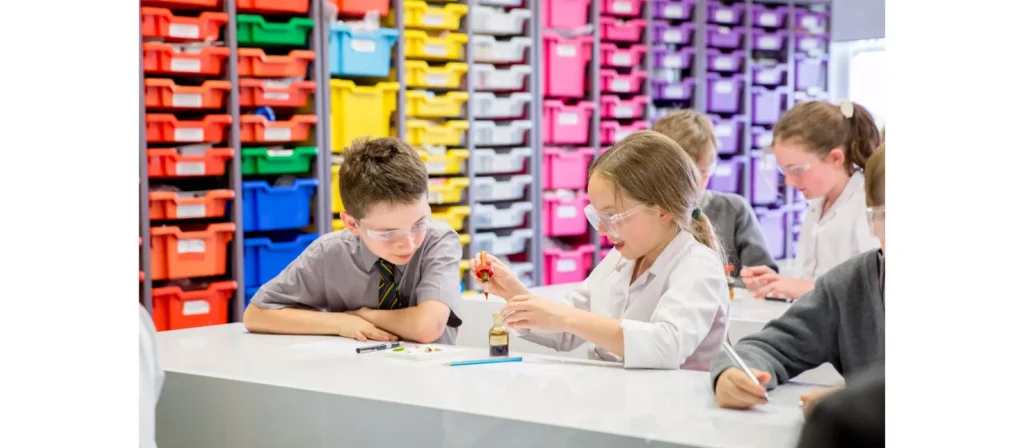
Étapes clés du développement :
- Comprend la conservation de la masse, du nombre et du volume
- Peut classer et sérialiser des objets (par exemple, trier par taille ou par rang)
- Commence à utiliser la logique inductive basée sur des informations spécifiques
- Comprendre le concept de temps, de séquence et de relations
- Comprend plus précisément les points de vue des autres
- Élabore des stratégies de planification et de résolution de problèmes
Stratégies pour soutenir les progrès des enfants dans le domaine cognitif :
- Intégrez des tâches de résolution de problèmes de la vie réelle, telles que la cuisine, la budgétisation ou la lecture de cartes
- Utilisez des expériences scientifiques pratiques pour explorer la relation de cause à effet
- Introduire des objets mathématiques pour renforcer les opérations et les relations
- Jouez à des jeux de société qui nécessitent de la stratégie, de la planification ou de la mémoire
- Encouragez les discussions de groupe et l'apprentissage entre pairs pour développer la communication et l'empathie
- Utiliser des organisateurs graphiques et des tableaux pour enseigner la classification et les relations
Étape opérationnelle formelle (12 ans et plus)
À ce stade final, les adolescents développent leur capacité à penser de manière abstraite, à raisonner logiquement et à planifier systématiquement. Ils peuvent envisager des situations hypothétiques, en analyser les conséquences et débattre d'idées éthiques ou philosophiques. Ce stade permet une résolution de problèmes avancée et une métacognition (réflexion sur la pensée).
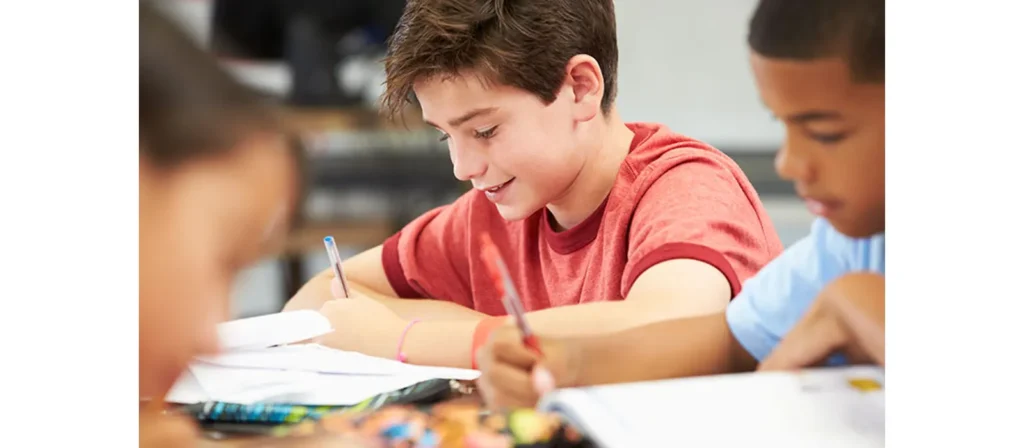
Étapes clés du développement :
- Pense de manière abstraite et hypothétique
- S'engage dans un raisonnement scientifique et teste des hypothèses
- Considère de multiples perspectives et possibilités futures
- Comprend les relations complexes de cause à effet
- Développe les valeurs personnelles, les croyances et l'identité
- Réfléchit à ses processus de pensée (métacognition)
Stratégies pour soutenir les progrès des enfants dans le domaine cognitif :
- Encourager les débats, les discussions et les exercices de pensée critique
- Attribuer des projets ouverts qui nécessitent de la planification, de la recherche et de la créativité
- Offrir des opportunités de définition d’objectifs et d’autoréflexion
- Explorez les dilemmes éthiques, la littérature ou les problèmes sociaux pour une réflexion plus approfondie
- Introduire des concepts abstraits en sciences, mathématiques et philosophie
- Soutenir l'apprentissage indépendant grâce à la journalisation, aux activités basées sur l'enquête et aux outils technologiques
Pourquoi les domaines de développement cognitif sont importants
| Domaine des compétences cognitives | Impact positif |
|---|---|
| Résolution de problèmes | Améliore la pensée critique, encourage l'exploration et soutient le raisonnement logique |
| Mémoire et attention | Améliore la capacité à suivre les instructions, à retenir de nouvelles informations et à rester concentré |
| Traitement du langage | Favorise la compréhension, la narration et l'expansion du vocabulaire |
| Compréhension du concept | Établit les bases des mathématiques, des sciences et de l'alphabétisation grâce à la catégorisation et au raisonnement |
| Fonction exécutive | Développe l'autorégulation, la gestion des tâches et l'établissement d'objectifs |
| Pensée abstraite | Prépare les enfants à l'apprentissage avancé, au raisonnement hypothétique et à l'expression créative |
| Motivation d'apprentissage | Favorise la curiosité, la persévérance et les comportements d'apprentissage indépendants |
| Compréhension sociale | Aide à interpréter les signaux sociaux, à résoudre les problèmes interpersonnels et à développer l'empathie |
Domaines de développement du langage
Le développement du langage est essentiel à la croissance de la petite enfance. Il façonne la façon dont les enfants communiquent, interagissent avec les autres et découvrent le monde. Il englobe de nombreuses compétences, notamment l'écoute, l'expression orale, l'acquisition du vocabulaire, la grammaire et la capacité conversationnelle. Ces compétences influencent la communication et sous-tendent les relations sociales, l'expression émotionnelle, le développement cognitif et la préparation scolaire.
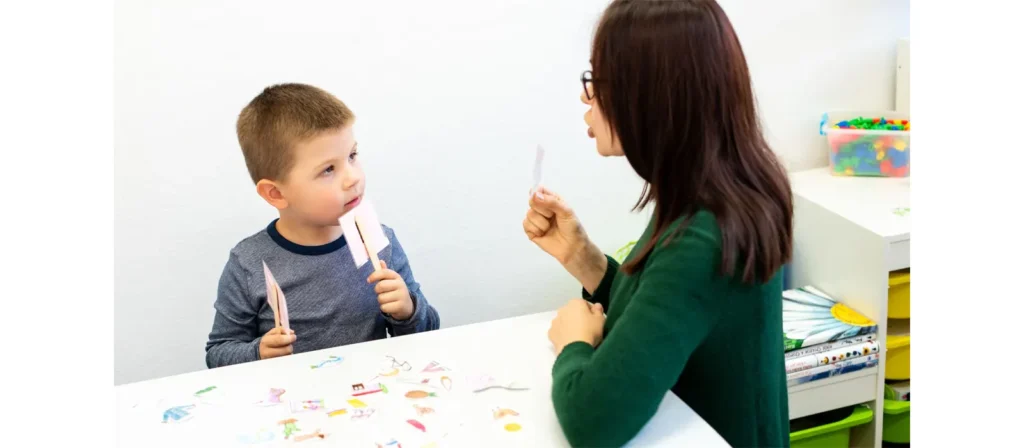
Langage expressif vs. langage réceptif
Le développement du langage comprend deux composantes essentielles et interdépendantes : le langage réceptif et le langage expressif. Bien que ces compétences se développent simultanément, elles suivent des trajectoires différentes et nécessitent des stratégies de soutien spécifiques pour assurer une croissance équilibrée. Comprendre cette différence permet aux soignants et aux éducateurs d'adapter les interactions et les environnements aux besoins de développement de l'enfant.
Qu’est-ce que le langage réceptif ?
Le langage réceptif désigne la compréhension et le traitement du langage entendu ou lu. Il comprend la compréhension des mots, des phrases, des instructions, des questions et des signaux sociaux. Cette compétence se développe souvent avant le langage expressif, ce qui signifie que les enfants peuvent comprendre davantage qu'ils ne peuvent exprimer verbalement.
Indicateurs clés du développement du langage réceptif :
- Répond à son nom
- Suit les instructions verbales (par exemple, « Donne-moi le ballon »)
- Indique des objets ou des personnes nommés
- Comprend des questions de base comme « Où est ta chaussure ? »
- Réagit de manière appropriée au ton de la voix (par exemple, heureux ou en colère)
Qu’est-ce que le langage expressif ?
Le langage expressif désigne la capacité d'un enfant à communiquer ses pensées, ses besoins, ses sentiments et ses idées par la parole, les gestes, les signes ou l'écrit. Ce domaine implique l'utilisation du vocabulaire, la construction de phrases, la narration et la capacité à nommer des objets ou des actions.
Indicateurs clés du développement du langage expressif :
- Utilise des mots simples, puis des phrases courtes, puis des phrases complètes
- Pose des questions et exprime des désirs ou des émotions
- Raconte des événements ou des nouvelles
- Nommez les personnes, les objets et les actions
- Utilise des formes grammaticales appropriées à l'âge
Tableau comparatif des langages expressifs et réceptifs
| Aspect | Langage réceptif | Langage expressif |
|---|---|---|
| Définition | La capacité de comprendre la langue parlée, écrite ou signée | La capacité de communiquer des pensées, des besoins et des idées |
| Ordonnance de développement | Se développe généralement plus tôt | Se développe plus tard à mesure que le vocabulaire et les compétences cognitives se développent |
| Exemples | Nommer des objets, former des phrases et poser des questions | Points pour corriger l'image lorsqu'on le lui demande, répond aux commandes |
| Objectif d'apprentissage | Comprendre le vocabulaire, la grammaire et la signification des messages | Utiliser le langage pour s'exprimer clairement et efficacement |
| Compétences clés impliquées | Écoute, attention, compréhension | Parler, utiliser le vocabulaire, structure des phrases |
| Stratégies de soutien | Utilisez des éléments visuels, simplifiez le langage, répétez les instructions et posez des questions par oui ou par non. | Développez les phrases de l'enfant, proposez des choix et modélisez des phrases complètes |
| Signes de retard courants | Ne répond pas au nom, ne suit pas les instructions | Suivre les instructions, identifier les objets et réagir aux noms |
Développement du langage à différents âges
Le développement du langage durant la petite enfance est un processus dynamique en plusieurs phases, au cours duquel les enfants apprennent à comprendre et à utiliser la communication orale, écrite et gestuelle. Bien que le rythme d'acquisition du langage puisse varier, certains schémas et étapes clés sont généralement observés dans certaines tranches d'âge. L'identification précoce des retards et la création d'environnements intentionnellement riches en langage sont essentielles pour favoriser une croissance optimale.
Nourrissons (de la naissance à 12 mois)
Étapes clés du développement :
0–3 mois :
- Des cris pour exprimer des besoins
- Réagit aux voix et aux sons familiers
- Commence à roucouler et à émettre des sons ressemblant à des voyelles
4 à 6 mois :
- Tourne la tête vers les sons
- Commence à babiller (par exemple, « ba », « da »)
- Reconnaît son propre nom et réagit au ton de la voix
7–9 mois :
- Utilise un babillage avec une variété de sons et de hauteurs
- Reconnaît les mots courants comme « non » et « au revoir »
- Utilise des gestes comme tendre la main ou pointer du doigt
10–12 mois :
- Peut dire le premier mot (par exemple, « maman », « papa »)
- Comprend des commandes simples (« viens ici », « donne-moi »)
- Utilise des gestes et des vocalisations ensemble pour communiquer
Stratégies pour soutenir le développement du langage :
- Parlez constamment et racontez les routines quotidiennes, en décrivant les objets et les actions (« Maintenant, je change ta couche »).
- Engagez des conversations en face à face et répondez aux roucoulements et aux babillages pour encourager les échanges à tour de rôle.
- Lisez quotidiennement des livres cartonnés simples, en pointant des images et en nommant des éléments.
- Utilisez un discours destiné aux nourrissons (tonalités plus aiguës et exagérées) pour retenir l’attention et modéliser le langage.
- Chantez des comptines et des chansons avec des mouvements de mains pour développer le rythme et le vocabulaire.
- Nommez et décrivez les émotions et les expériences sensorielles (« Tu as froid. Allons chercher ta couverture. »).
Tout-petits (1 à 3 ans)
Étapes clés du développement :
12–18 mois :
- Dit 5 à 20 mots
- Utilise des gestes simples (agiter, secouer la tête)
- Suit des instructions simples (« viens ici », « assieds-toi »)
18–24 mois :
- Le vocabulaire s'étend à plus de 50 mots
- Combine deux mots en phrases simples (« plus de jus »)
- Commence à poser et à répondre à des questions simples
24–36 mois :
- Le vocabulaire s'étend jusqu'à 200 à 500 mots
- Utilise systématiquement des phrases de 2 à 3 mots
- Comprend les contraires, les catégories et les pronoms de base
Stratégies pour soutenir le développement du langage :
- Étiquetez tout ce qui se trouve dans l’environnement et répétez souvent les nouveaux mots.
- Lire divers livres, encourageant votre enfant à pointer, étiqueter et répéter des mots.
- Utilisez le discours parallèle (« Tu pousses le camion ! ») et le dialogue intérieur (« Je verse le lait ») pour modéliser le langage.
- Posez des questions ouvertes et laissez du temps pour les réponses.
- Jouez avec des jouets qui suscitent le jeu de simulation, comme des poupées, des animaux ou des cuisines de jeu.
- Chantez des chansons avec des phrases répétitives et faites des jeux de doigts pour soutenir la mémoire et les schémas linguistiques.
Enfants d'âge préscolaire (3 à 5 ans)
Étapes clés du développement :
3–4 ans :
- Utilise des phrases de 4 à 5 mots
- Parle suffisamment pour être compris la plupart du temps
- Raconte des histoires simples et rappelle des parties d'une histoire
- Pose fréquemment des questions du type « pourquoi », « quoi », « comment »
4–5 ans :
- Utilise des phrases plus complexes avec la grammaire (passé, pluriel)
- Comprend les concepts liés au temps (hier, aujourd'hui, demain)
- Poursuit des conversations plus longues
- Commence à reconnaître certaines lettres et certains sons
Stratégies pour soutenir le développement du langage :
- Lisez des livres d’images plus complexes et posez des questions prédictives et de rappel.
- Développez ce que disent les enfants en ajoutant des détails (« Oui, le chien aboie parce qu’il entend un bruit. »).
- Fournir des marionnettes et des accessoires de narration pour encourager le langage expressif.
- Encouragez les enfants à parler de leurs sentiments et de leurs expériences.
- Soutenir le jeu dramatique où les enfants assument différents rôles et pratiquent des dialogues.
- Utilisez des jeux de rimes et des chansons pour développer la conscience phonologique et l’alphabétisation précoce.
Pourquoi les domaines de développement du langage sont importants
| Zone d'avantages | Impact positif |
|---|---|
| Communication efficace | Permet aux enfants d'exprimer clairement leurs pensées, leurs besoins et leurs émotions |
| Des relations plus solides | Favorise les liens sociaux par le biais de conversations, d'empathie et de coopération |
| Préparation à l'école | Prépare les enfants à lire, à écrire et à comprendre les consignes de classe |
| Régulation émotionnelle | Permet aux enfants d'étiqueter et d'exprimer leurs sentiments, réduisant ainsi la frustration |
| Croissance cognitive | Améliore la résolution de problèmes, le raisonnement et la mémoire grâce au dialogue interne et verbal |
| Confiance et indépendance | Renforce la confiance en soi en permettant des interactions sociales et académiques réussies |
| Sensibilisation culturelle et sociale | Encourage l’appréciation de perspectives diverses grâce à l’exposition à la langue |
| Compétences d'apprentissage tout au long de la vie | Favorise la pose de questions, le partage d'idées et la participation active à l'apprentissage |
Domaines de développement socio-émotionnel
Le développement socio-émotionnel est une composante essentielle de la croissance de la petite enfance. Il se concentre sur la façon dont les enfants comprennent et gèrent leurs émotions, établissent des relations positives et font des choix responsables. Il influence directement le comportement, l'image de soi et la capacité d'un enfant à interagir efficacement en groupe. Contrairement aux compétences cognitives ou physiques, les compétences socio-émotionnelles sont intimement liées au bien-être émotionnel et se développent souvent grâce à des soins attentionnés, aux interactions avec ses pairs et à des environnements émotionnellement riches.
Les aspects clés du développement socio-émotionnel comprennent :
- Conscience de soi : Reconnaître ses propres émotions, pensées et valeurs et comment elles influencent le comportement.
- Autorégulation : Gérer les émotions, les pensées et les comportements dans différentes situations ; comprend le contrôle des impulsions et la gestion du stress.
- Conscience sociale : Comprendre et faire preuve d’empathie envers les autres, y compris ceux issus d’horizons et de cultures divers.
- Compétences relationnelles : Établir et maintenir des relations saines et enrichissantes grâce à la communication, à la coopération et à la résolution des conflits.
- Prise de décision responsable : Faire des choix respectueux et constructifs basés sur des normes éthiques, de sécurité et des normes sociales.
Développement socio-émotionnel à différents âges
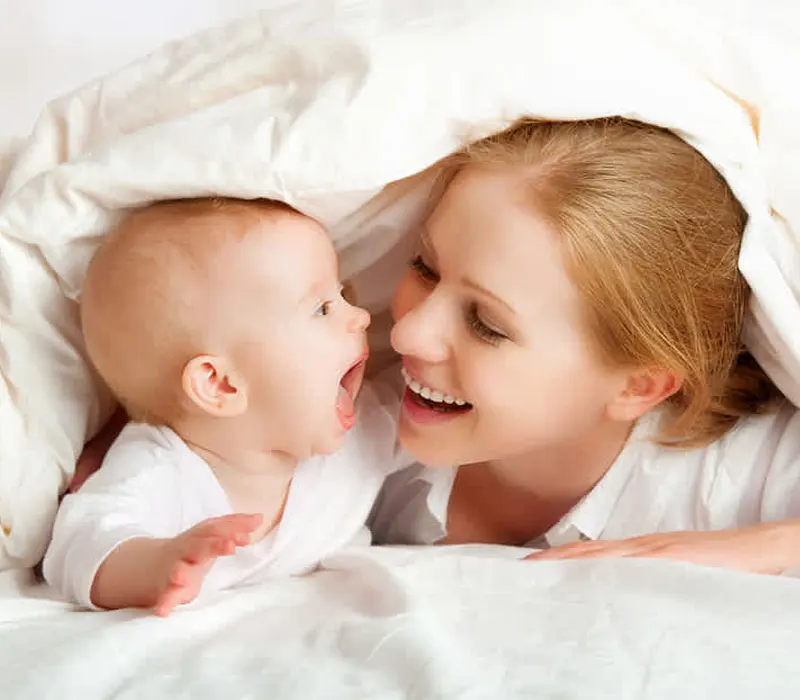
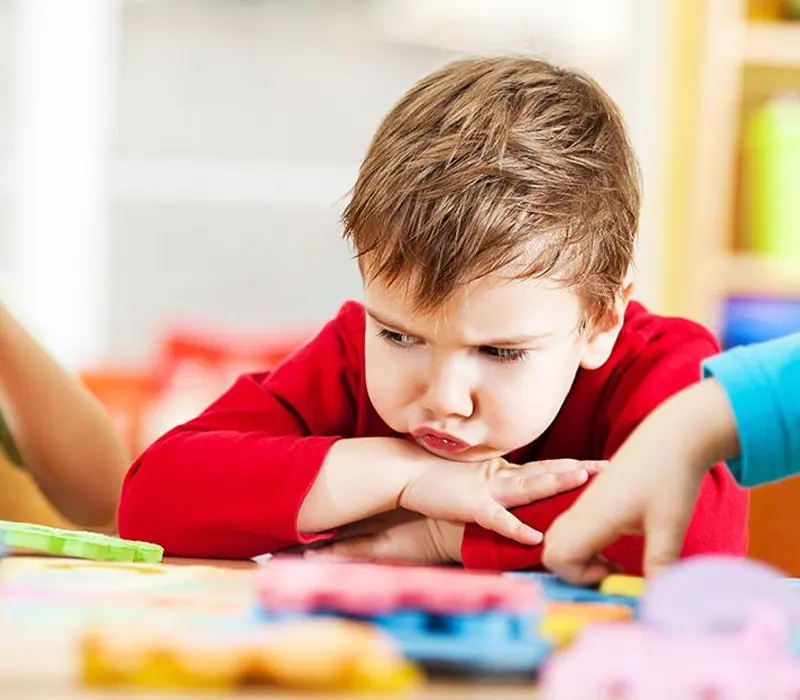

Nourrissons (de la naissance à 12 mois)
Étapes clés du développement :
- Montre de l'intérêt pour les soignants familiers
- Sourires en réponse aux autres (sourire social)
- Commence à montrer une gamme d’émotions (joie, peur, détresse)
- Présente des comportements d'attachement (se tourne vers les personnes qui s'occupent de lui, pleure lorsqu'il est séparé)
- Réagit aux expressions faciales et au ton de la voix
Stratégies de soutien au développement :
- Adopter des soins cohérents et réactifs pour renforcer la confiance et l’attachement
- Établissez un contact visuel, souriez et reproduisez les expressions faciales lors des interactions
- Offrir un environnement calme et prévisible pour favoriser la sécurité émotionnelle
- Réconfortez et reconnaissez les émotions des nourrissons par le toucher et la voix apaisants
- Participez à des jeux en face à face et à des interactions vocales pour favoriser le lien émotionnel
Tout-petits (1 à 3 ans)
Étapes clés du développement :
- Montre des préférences pour les personnes et les jouets
- Exprime une gamme plus large d’émotions (frustration, fierté, jalousie)
- Commence à faire preuve d’empathie et à offrir du réconfort aux autres
- Fait preuve d'un comportement provocateur et recherche l'autonomie
- Expérimente et apprend à gérer les crises de colère
Stratégies de soutien au développement :
- Proposez des limites et des routines claires pour créer un sentiment de sécurité
- Reconnaître et nommer les émotions (« Tu es triste parce que le jouet a disparu »)
- Soyez un modèle de compétences d’adaptation saines comme la respiration profonde ou l’utilisation de mots pour exprimer votre frustration.
- Utilisez des histoires sociales simples ou des marionnettes pour expliquer les émotions et les réponses appropriées
- Encouragez le jeu indépendant et les activités de groupe avec des conseils doux
Enfants d'âge préscolaire (3 à 5 ans)
Étapes clés du développement :
- S'engage dans un jeu coopératif et commence à prendre son tour
- Identifie et parle de ses sentiments et de ceux des autres
- Utilise des mots plus fréquemment pour résoudre les conflits
- Montre un meilleur contrôle émotionnel et un retard de gratification
- Commence à comprendre l'équité, l'empathie et l'amitié
Stratégies de soutien au développement :
- Créer des opportunités de jeu en groupe, de tâches collaboratives et de jeux de rôle
- Continuez à utiliser le vocabulaire émotionnel pour parler de situations réelles et d'histoires
- Félicitez les comportements prosociaux comme le partage, l’entraide ou la gentillesse
- Utilisez des coins de détente ou des outils sensoriels pour enseigner des stratégies d'autorégulation
- Présentez des livres et des jeux axés sur les émotions et la résolution de problèmes
Pourquoi le développement socio-émotionnel est-il important ?
| Zone d'avantages | Impact positif |
|---|---|
| Régulation émotionnelle | Aide les enfants à gérer la frustration, l'anxiété et l'excitation de manière saine |
| Établissement de relations | Favorise les amitiés, la coopération et les interactions positives entre pairs |
| Préparation académique | Améliore la concentration, le contrôle des impulsions et la persévérance dans les tâches, essentiels à la réussite de l'apprentissage |
| Confiance en soi | Encourage l'indépendance, la motivation et la volonté d'essayer de nouvelles choses |
| Résolution des conflits | Favorise la résolution de problèmes, la négociation et les interactions pacifiques |
| Empathie et compassion | Améliore la compréhension des sentiments des autres, favorisant la gentillesse et l'inclusion |
| Résilience | Développe les capacités d'adaptation et la capacité à se remettre des revers ou des déceptions |
| Comportement en classe | Réduit les comportements perturbateurs et améliore la participation du groupe |
| Compétences en matière de prise de décision | Favorise des choix réfléchis, sûrs et responsables |
Domaines de développement adaptatifs
Le développement adaptatif désigne les compétences dont les enfants ont besoin pour fonctionner de manière autonome au quotidien. Il englobe les capacités d'autonomie telles que se nourrir, s'habiller, aller aux toilettes, assurer leur hygiène personnelle, être conscient de la sécurité et suivre une routine. Ces compétences fondamentales permettent aux enfants de devenir plus autonomes, plus confiants et plus compétents à la maison, à l'école et dans la communauté. Les compétences adaptatives sont pratiques et observables, ce qui permet aux parents et aux éducateurs d'évaluer leur degré de préparation aux transitions comme l'entrée à la maternelle ou à la crèche.
Les enfants développent des capacités d'adaptation par l'observation, l'imitation, la répétition et la pratique guidée. Comme pour d'autres domaines du développement, les progrès peuvent varier en fonction de l'environnement, des attentes et du tempérament. Encourager et donner l'exemple d'une indépendance adaptée à l'âge est essentiel pour favoriser efficacement ce domaine.
Développement adaptatif à différents âges

Nourrissons (de la naissance à 12 mois)
Étapes clés du développement :
- Commence à tenir son biberon pendant la tétée
- Montre de l'intérêt à aider à s'habiller (par exemple, en poussant les bras à travers les manches)
- Initie des routines simples comme lever les bras lorsqu'on le soulève
- Communique son inconfort avec des couches mouillées ou sales
- Explore les textures des aliments et commence à s'alimenter seul avec les doigts
Stratégies pour soutenir le développement adaptatif :
- Offrir des possibilités sûres et supervisées d'auto-alimentation (aliments mous à manger avec les doigts, cuillères)
- Encouragez la participation à l'habillage en nommant les parties du corps et les vêtements
- Établissez des routines cohérentes pour l'alimentation, le bain et le sommeil
- Étiquetez et décrivez chaque étape des activités quotidiennes (« Maintenant, on essuie ta bouche »)
- Utilisez la langue des signes pour bébé pour les besoins de base (plus, terminé, boire)
Tout-petits (1 à 3 ans)
Étapes clés du développement :
- Se nourrit seul à l'aide d'une cuillère et boit dans une tasse avec un minimum de déversements
- Commence l'apprentissage de la propreté ; signale le besoin d'utiliser les toilettes
- Aide au déshabillage et à l'habillage (enlever les chaussettes, mettre un chapeau)
- Suit des routines simples avec des conseils (se brosser les dents, se laver les mains)
- Commence à montrer sa conscience de la sécurité (par exemple, éviter les objets chauds ou tranchants)
Stratégies pour soutenir le développement adaptatif :
- Offrir des occasions quotidiennes de pratiquer les soins personnels avec des encouragements verbaux
- Utilisez des calendriers visuels ou des cartes illustrées pour des routines étape par étape
- Choisissez des vêtements avec des attaches faciles pour vous entraîner à vous habiller (velcro, taille élastique)
- Encouragez la responsabilité par des tâches simples (ranger les jouets, mettre la table)
- Privilégiez l’effort à la perfection pour renforcer la confiance et la persévérance
Enfants d'âge préscolaire (3 à 5 ans)
Étapes clés du développement :
- S'habille et se déshabille avec un minimum d'aide, y compris des boutons et des fermetures à glissière
- Entièrement formé à la propreté et gère les routines d'hygiène (essuyage, chasse d'eau, lavage des mains)
- Préparer des collations simples (étaler, verser, ouvrir des contenants)
- Suit des routines en plusieurs étapes et des transitions entre les activités
- Démontre une conscience de la sécurité (s'arrêter aux passages piétons, éviter les étrangers)
Stratégies pour soutenir le développement adaptatif :
- Créer des opportunités de prise de décision (choisir une tenue, choisir une collation)
- Encouragez l'indépendance dans les tâches quotidiennes avec des rappels doux, sans le faire à leur place.
- Utilisez des tableaux de routine avec des images ou des icônes pour renforcer les habitudes étape par étape
- Modéliser et pratiquer des comportements de sécurité (comment traverser la rue, que faire en cas d'urgence)
- Permettre aux enfants de participer aux activités de préparation des repas, de nettoyage et d'organisation
Pourquoi le développement adaptatif est-il important ?
| Zone d'avantages | Impact positif |
|---|---|
| Indépendance | Permet aux enfants de gérer les routines quotidiennes en toute confiance et réduit la dépendance aux adultes |
| Estime de soi | Crée un sentiment de compétence et de fierté dans l'accomplissement de tâches par soi-même |
| Préparation à l'école | Prépare les enfants à des environnements structurés qui exigent une responsabilité personnelle |
| résolution de problèmes | Encourage la pensée critique et le séquençage logique dans la prise de décision quotidienne |
| Santé et sécurité | Favorise les habitudes qui favorisent l'hygiène, la nutrition et la sensibilisation aux risques |
| Adhésion de routine | Aide les enfants à s'adapter aux horaires et à effectuer une transition en douceur entre les tâches |
| Participation de la famille | Permet aux enfants de contribuer aux tâches ménagères et de se sentir valorisés |
Pourquoi nous devons comprendre les différents domaines de développement
Les domaines physique, cognitif, langagier, socio-émotionnel et adaptatif contribuent de manière unique au bien-être et au potentiel de l'enfant. Lorsque les soignants, les éducateurs et les familles reconnaissent la valeur de chaque domaine et la manière dont ils interagissent, ils peuvent mieux identifier les points forts des enfants, répondre à leurs besoins et favoriser un développement sain et équilibré.
Développement holistique de l'enfant
Comprendre tous les domaines du développement nous permet d'appréhender l'enfant dans sa globalité, et pas seulement ses résultats scolaires ou son comportement. Un enfant peut exceller sur le plan cognitif mais rencontrer des difficultés sociales, ou être physiquement actif mais présenter un retard de communication. En prenant en compte tous les aspects du développement, nous favorisons une croissance équilibrée où le bien-être émotionnel, la coordination physique, la communication, l'autonomie et l'apprentissage progressent harmonieusement. Cette approche globale réduit les lacunes, prévient les oublis et favorise la résilience et l'adaptabilité des enfants.

Stratégies éducatives sur mesure
Reconnaître le développement des enfants dans différents domaines permet aux enseignants d'adapter leurs méthodes pédagogiques aux besoins des élèves. Par exemple, les enfants dont le langage est développé mais dont la motricité fine est limitée pourraient bénéficier d'un enseignement verbal associé à du matériel adapté. Un enfant présentant des difficultés socio-émotionnelles pourrait avoir besoin d'interactions plus structurées avec ses pairs. Adapter l'enseignement en fonction de l'analyse du développement garantit un apprentissage accessible, équitable et efficace pour des apprenants divers.
Il permet une détection et un soutien précoces
Lorsque les adultes comprennent les étapes typiques de chaque domaine de développement, ils sont mieux à même d'identifier les situations où quelque chose ne progresse pas comme prévu. Cette prise de conscience conduit à des interventions plus précoces, qui se révèlent plus efficaces pour favoriser la réussite à long terme de l'enfant. Une identification précoce peut contribuer à réduire la frustration, à prévenir les difficultés secondaires et à promouvoir des pratiques éducatives inclusives et adaptées.
Renforcer les relations enseignant-enfant
La connaissance du développement permet aux éducateurs d'interpréter les comportements avec précision et d'y répondre avec sensibilité. Au lieu de qualifier un enfant de « difficile », un enseignant qui comprend les domaines du développement peut y voir le signe d'une autorégulation limitée ou d'un retard de langage. Cette empathie renforce la confiance et améliore la relation enseignant-enfant, ce qui, comme le montrent les recherches, est un facteur clé de sécurité émotionnelle et de réussite scolaire.
Renforcer l'implication de la famille
Lorsque les parents et les personnes qui s'occupent d'eux comprennent les attentes en matière de développement, ils deviennent des partenaires plus actifs dans la croissance de l'enfant. Les éducateurs peuvent utiliser des cadres de développement pour communiquer clairement avec les familles, suggérer des activités enrichissantes à la maison et définir des objectifs communs. Cette collaboration renforce le lien entre la maison et l'école, assure une cohérence entre les environnements et offre aux enfants un réseau de soutien plus solide.
Les domaines de développement sont-ils interdépendants ou indépendants ?
Les domaines du développement sont étroitement liés et non indépendants. Bien que les domaines physique, cognitif, langagier, socio-émotionnel et adaptatif représentent des axes de croissance distincts, ils interagissent de manière dynamique et s'influencent mutuellement. Les enfants ne se développent pas de manière isolée ; les progrès ou les retards dans un domaine peuvent avoir un impact significatif sur les autres.
Exemples de développement interconnecté :
- Un enfant présentant un retard de motricité fine (domaine physique) peut avoir des difficultés à écrire, ce qui peut affecter ses performances scolaires (domaine cognitif).
- Un jeune enfant ayant des compétences linguistiques limitées (domaine du langage) peut avoir des difficultés à exprimer sa frustration, ce qui entraîne des problèmes de comportement (domaine socio-émotionnel).
- Une mauvaise autorégulation (domaine socio-émotionnel) peut rendre difficile pour un enfant de participer à des activités de groupe, limitant ainsi ses capacités d’adaptation comme le suivi de routines ou les soins personnels.
- De fortes capacités cognitives peuvent favoriser une acquisition plus rapide du vocabulaire et une structure de phrases complexes, démontrant ainsi un lien positif entre la cognition et le développement du langage.
Retard des domaines de développement
Les retards de développement surviennent lorsqu'un enfant n'atteint pas les objectifs attendus dans la tranche d'âge habituelle dans un ou plusieurs domaines, tels que le langage, la motricité, les compétences socio-émotionnelles, cognitives ou adaptatives. Bien que les enfants grandissent à des rythmes différents, des écarts persistants de développement peuvent signaler la nécessité d'une évaluation et d'un soutien. Comprendre les causes, reconnaître les signes précoces et réagir de manière appropriée est essentiel pour garantir à chaque enfant les chances de s'épanouir.
Causes courantes
Les retards de développement peuvent résulter de divers facteurs biologiques, environnementaux et sociaux. Parfois, la cause est identifiable ; dans d'autres cas, les retards peuvent résulter d'une combinaison de facteurs.
- Affections génétiques ou neurologiques (par exemple, syndrome de Down, paralysie cérébrale, trouble du spectre autistique)
- Une naissance prématurée ou un faible poids à la naissance peuvent affecter le développement précoce du cerveau et la croissance physique
- Problèmes de santé chroniques ou complications médicales pendant la petite enfance
- Déficiences auditives ou visuelles qui interfèrent avec le langage et le développement social
- Manque de stimulation ou d’interaction réactive dans l’environnement familial
- L’exposition à un traumatisme ou à la négligence peut avoir un impact sur la croissance émotionnelle et cognitive
- Carences nutritionnelles, en particulier pendant les premières années critiques
- Toxines environnementales (par exemple, exposition au plomb)
Signes de retards de développement
La détection précoce des retards de développement est essentielle. Voici quelques signes avant-coureurs courants dans différents domaines. Ces signes ne sont pas toujours révélateurs d'un retard, mais des tendances constantes au fil du temps justifient une évaluation plus approfondie.
Développement physique :
- Difficulté à s'asseoir, à ramper ou à marcher à l'âge prévu
- Faible tonus musculaire ou coordination limitée
- Difficultés avec les tâches de motricité fine comme saisir ou s'alimenter seul
Développement cognitif :
- Difficulté à suivre des instructions simples ou à résoudre des problèmes fondamentaux
- Curiosité ou exploration limitée de l'environnement
- Incapacité à se concentrer ou à accomplir des tâches adaptées à son âge
Développement du langage :
- Pas de babillage à 12 mois ou pas de mots à 18 mois
- Vocabulaire limité pour l'âge ; difficulté à former des phrases
- Mauvaise compréhension des commandes ou des questions de base
Développement socio-émotionnel :
- Évite le contact visuel ou manque d'intérêt à interagir avec les autres
- Incapacité à gérer les émotions ou les crises de colère extrêmes au-delà de l'âge typique
- Difficulté à nouer des relations ou à répondre aux signaux sociaux
Développement adaptatif :
- Retards dans les tâches d'autosoins comme se nourrir, s'habiller ou aller aux toilettes
- Incapacité à suivre les routines quotidiennes
- Dépendance à l'égard des adultes pour les responsabilités adaptées à l'âge
Comment intervenir ?
Une intervention précoce et intentionnelle peut profondément influencer le développement d'un enfant. Plus le soutien est apporté tôt, plus l'enfant a de chances de rattraper son retard ou d'acquérir les outils nécessaires pour s'adapter efficacement.
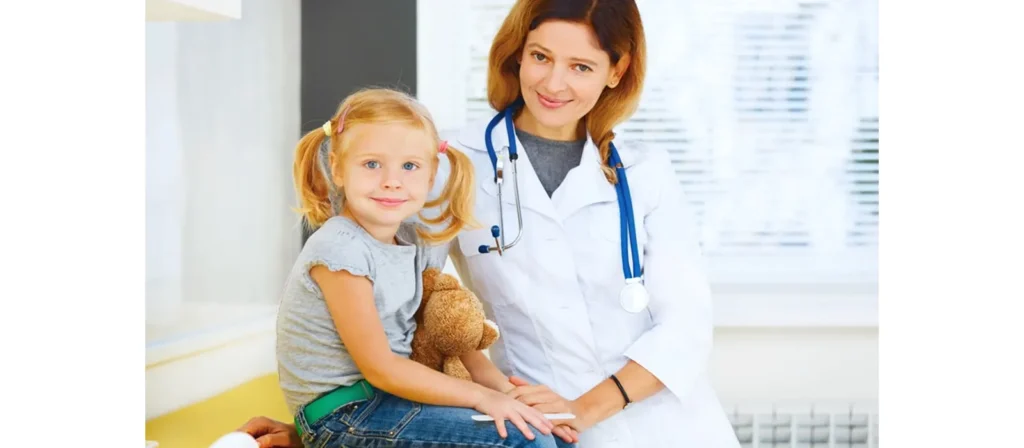
1. Demandez une évaluation professionnelle :
Consultez des pédiatres, des spécialistes de la petite enfance ou des psychologues du développement pour effectuer un dépistage ou une évaluation complète du développement.
2. Accéder aux services d’intervention précoce :
De nombreuses régions offrent des services gratuits ou subventionnés aux enfants de moins de 5 ans par le biais de programmes gouvernementaux, notamment l’orthophonie, la physiothérapie et l’ergothérapie.
3. Plans de soutien individualisés :
Travaillez avec des éducateurs ou des spécialistes pour créer des plans personnalisés tels qu'un plan de services familiaux individualisé (IFSP) ou un programme d'éducation individualisé (IEP), selon l'âge de l'enfant.
4. Créez un environnement favorable :
Établissez des routines cohérentes, proposez des interactions riches en langage et offrez un environnement stimulant mais sûr pour l’exploration et l’apprentissage.
5. Collaborer avec les familles et les éducateurs :
La collaboration entre les professionnels et les soignants assure la cohérence et le renforcement des stratégies de développement dans tous les environnements.
6. Surveillez régulièrement les progrès :
Utilisez des listes de contrôle des étapes clés et des outils d’observation pour suivre les améliorations et ajuster les stratégies de soutien selon les besoins.
Une approche holistique des domaines de développement
Une approche holistique considère le développement de l'enfant comme un processus interconnecté, où la croissance dans un domaine influence et soutient les progrès dans d'autres. Pour mettre en œuvre efficacement cette approche, les éducateurs et les soignants doivent appliquer des stratégies intentionnelles qui prennent en compte l'enfant dans sa globalité. Vous trouverez ci-dessous les principaux éléments de cette pratique, structurés en domaines distincts pour plus de clarté et de profondeur.
Intégrer les domaines de développement à travers les expériences quotidiennes
L'une des façons les plus efficaces de favoriser un développement holistique est de concevoir des activités qui sollicitent simultanément plusieurs domaines. Par exemple, la lecture d'une histoire gagne en puissance lorsqu'elle est associée à des stimulations basées sur le mouvement, à des jeux de rôle imaginatifs ou à des questions complémentaires favorisant la réflexion. Les activités culinaires peuvent intégrer des compétences physiques (motricité fine), cognitives (mesures), sociales (tour de rôle) et adaptatives (suivi de routines) dans un contexte unique et pertinent. De telles expériences favorisent un apprentissage plus riche en intégrant différents aspects du développement dans une expérience unifiée.
Apprentissage par le jeu
Le jeu est un vecteur naturel et essentiel de développement global. Grâce aux jeux de simulation, les enfants pratiquent le langage, gèrent leurs émotions, explorent les rôles sociaux et testent des idées en toute sécurité et autonomie. Les enfants exercent constamment divers muscles du développement, qu'il s'agisse de construire avec des blocs, de jouer aux pompiers ou de jouer à un jeu de mémoire. Les éducateurs peuvent maximiser cet avantage en proposant des activités ludiques. matériaux ouverts, en observant les thèmes de jeu des enfants et en développant doucement leurs idées avec des questions ou des défis.
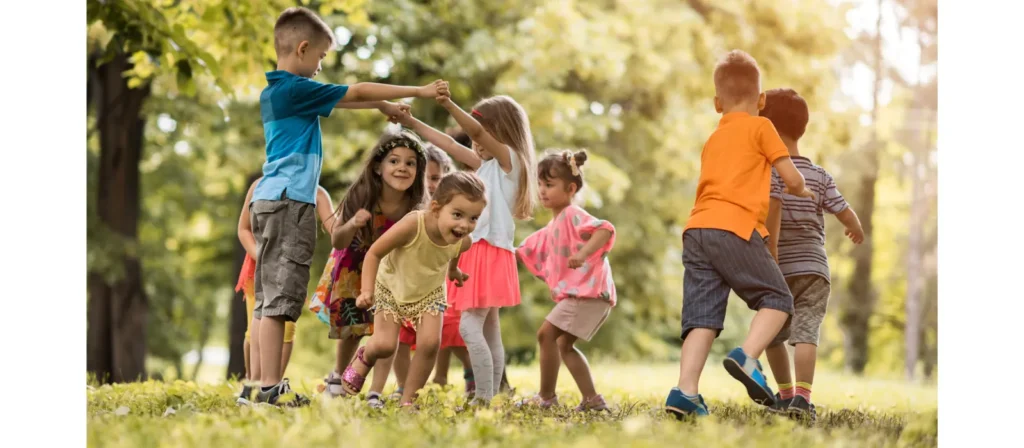
Construire des relations émotionnellement réactives
Au cœur du développement holistique se trouve un lien affectif sécurisant. Les enfants qui se sentent en sécurité et soutenus sont plus susceptibles de prendre des risques d'apprentissage, de s'exprimer et de surmonter les échecs. Des relations bienveillantes, où les adultes écoutent attentivement, reconnaissent les émotions et apportent un soutien constant, favorisent le développement socio-émotionnel et créent la confiance nécessaire au développement cognitif et comportemental. Ces interactions sont un modèle d'empathie, de résolution de problèmes et de communication respectueuse.
Partenariat avec les familles pour étendre l'apprentissage
Le développement holistique se poursuit au-delà de la classe, ce qui rend l'implication familiale essentielle. Lorsque les parents comprennent les domaines de développement et comment les soutenir, les enfants bénéficient de cohérence et de renforcement à la maison. Des routines simples comme préparer les repas, lire des histoires avant le coucher ou ranger peuvent devenir de formidables opportunités de développement lorsque les parents sont intentionnels et communicatifs. Les enseignants peuvent soutenir ce partenariat en partageant des stratégies, en expliquant les comportements observés et en encourageant les retours familiaux.
Observer les enfants dans différents domaines
Une approche holistique exige des éducateurs une observation globale et approfondie des enfants. Plutôt que de se concentrer uniquement sur les repères scolaires, l'observation holistique consiste à observer la façon dont l'enfant communique, se déplace, interagit socialement et gère ses routines. Ces informations permettent d'identifier les points forts et les points faibles dans de multiples domaines, d'orienter un enseignement personnalisé et de guider les interventions appropriées si nécessaire. Elles garantissent également un soutien réactif et dynamique, s'adaptant à l'évolution des besoins de l'enfant.
FAQ
Quels sont les principaux domaines de développement de la petite enfance ?
Les cinq domaines de développement fondamentaux sont : physique, cognitif, langagier, socio-émotionnel et adaptatif. Chaque domaine reflète un aspect différent de la croissance et tous contribuent ensemble au développement global de l’enfant.
Que dois-je faire si je soupçonne un retard de développement chez un enfant ?
Commencez par observer et documenter les préoccupations spécifiques, puis consultez un pédiatre ou un spécialiste du développement. Des services d'intervention précoce sont souvent disponibles et très efficaces lorsqu'ils sont mis en place dès le plus jeune âge.
Comment les familles peuvent-elles soutenir tous les domaines du développement à la maison ?
Les familles peuvent utiliser les routines quotidiennes, comme les repas, les jeux ou le coucher, comme des occasions d'apprentissage. Parler, lire, jouer et impliquer les enfants dans des tâches simples comme s'habiller ou ranger contribuent à renforcer de multiples domaines de manière naturelle et significative.
Est-il normal que les enfants se développent plus rapidement dans certains domaines que dans d’autres ?
Oui. Les enfants présentent souvent un développement inégal : par exemple, un langage avancé mais une motricité plus lente. C'est normal, mais des retards persistants ou importants dans un domaine peuvent nécessiter une évaluation plus approfondie.
Le développement dans un domaine peut-il compenser le retard d’un autre ?
Bien que de solides compétences dans un domaine puissent en soutenir d'autres (par exemple, de bonnes compétences sociales favorisant le développement du langage), ces domaines ne sont pas interchangeables. Un soutien est néanmoins nécessaire dans les domaines en retard afin d'assurer une croissance équilibrée.
Quel rôle joue le jeu dans le soutien des domaines de développement ?
Le jeu est essentiel. Il allie naturellement développement physique, cognitif, langagier et socio-émotionnel. Le jeu libre et imaginatif développe la coordination, la communication, la résolution de problèmes et la compréhension émotionnelle.
Quels types de professionnels accompagnent les enfants présentant des retards de développement ?
Selon le domaine concerné, le soutien peut provenir d’orthophonistes, d’ergothérapeutes, de physiothérapeutes, de psychologues pour enfants, d’enseignants en éducation spécialisée ou d’équipes d’intervention précoce.
Conclusion
Comprendre les domaines du développement de la petite enfance offre une perspective puissante pour prendre soin de l'enfant dans sa globalité : physique, cognitif, émotionnel, linguistique et social. Ces domaines ne sont pas isolés ; ils sont profondément liés, chacun influençant les autres et façonnant la préparation de l'enfant à la vie, et pas seulement à l'école. En reconnaissant les étapes clés, en observant les comportements de manière holistique et en utilisant des stratégies réactives ancrées dans les routines et les relations du monde réel, les adultes peuvent offrir un soutien opportun, ciblé et transformateur.
Que vous soyez parent, enseignant, aidant ou spécialiste, votre rôle dans le développement d'un enfant est important. En abordant la croissance avec connaissance, compassion et intentionnalité, nous donnons aux enfants les bases nécessaires pour s'épanouir dès l'enfance et tout au long de leur vie. Le parcours du développement est complexe, mais chaque enfant peut atteindre son plein potentiel avec compréhension et soutien.




